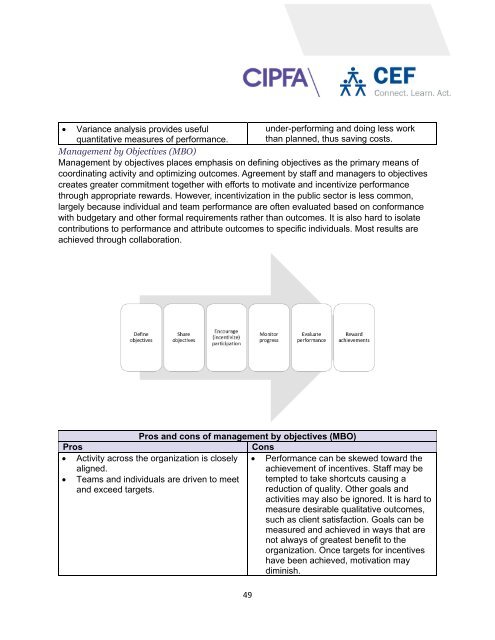Module 3B Managing Resources
Create successful ePaper yourself
Turn your PDF publications into a flip-book with our unique Google optimized e-Paper software.
• Variance analysis provides useful<br />
under-performing and doing less work<br />
quantitative measures of performance. than planned, thus saving costs.<br />
Management by Objectives (MBO)<br />
Management by objectives places emphasis on defining objectives as the primary means of<br />
coordinating activity and optimizing outcomes. Agreement by staff and managers to objectives<br />
creates greater commitment together with efforts to motivate and incentivize performance<br />
through appropriate rewards. However, incentivization in the public sector is less common,<br />
largely because individual and team performance are often evaluated based on conformance<br />
with budgetary and other formal requirements rather than outcomes. It is also hard to isolate<br />
contributions to performance and attribute outcomes to specific individuals. Most results are<br />
achieved through collaboration.<br />
Pros and cons of management by objectives (MBO)<br />
Cons<br />
Pros<br />
• Activity across the organization is closely<br />
aligned.<br />
• Teams and individuals are driven to meet<br />
and exceed targets.<br />
49<br />
• Performance can be skewed toward the<br />
achievement of incentives. Staff may be<br />
tempted to take shortcuts causing a<br />
reduction of quality. Other goals and<br />
activities may also be ignored. It is hard to<br />
measure desirable qualitative outcomes,<br />
such as client satisfaction. Goals can be<br />
measured and achieved in ways that are<br />
not always of greatest benefit to the<br />
organization. Once targets for incentives<br />
have been achieved, motivation may<br />
diminish.
















